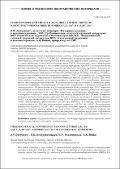| dc.contributor.author | Давыдова, О. В. | |
| dc.contributor.author | Дробышевская, Н. Е. | |
| dc.contributor.author | Подденежный, Е. Н. | |
| dc.contributor.author | Бойко, А. А. | |
| dc.coverage.spatial | Москва | |
| dc.date.accessioned | 2018-04-02T11:24:08Z | |
| dc.date.available | 2018-04-02T11:24:08Z | |
| dc.date.issued | 2017 | |
| dc.identifier.citation | Давыдова, О. В. Термохимический синтез и люминесцентные свойства наноструктурированных порошков Y2O3:Eu3+ и Y2O3:Bi3+,Eu3+ / О. В. Давыдова [и др.] // Тонкие химические технологии. - 2017. - Т. 12, № 1. - С. 31-38. | ru_RU |
| dc.identifier.uri | https://elib.gstu.by/handle/220612/18718 | |
| dc.description.abstract | Предложен новый метод термохимического синтеза люминесцентных наноструктуриро-ванных порошков Y2 O3 :Eu3 + и Y2 O3 :Bi3+,Eu3+, основанный на процессе горения нитратов соот-ветствующих металлов в присутствии комплексного органического горючего, состоящего из смеси карбамида и гексаметилентетрамина (ГМТА). | ru_RU |
| dc.description.abstract | This article describes a new method of thermochemical synthesis of luminescent nanostructured powders of Y2O3:Eu3+ and Y2O3:Bi3+, Eu3+ based on the burning of nitrate salts in the presence of a
complex organic fuel consisting of a mixture of carbamide and hexamethylenetetramine (HMTA). It is established that using a combined fuel – a mixture of carbamide and HMTA – in a thermochemical reaction
followed by calcination of the precursor at 650ºC gives more friable powders than the reaction with pure carbamide as a fuel, with a large amount of cavities. It is shown that when preparing Y2O3:Eu3+powders, complex compounds of anhydrous nitrates Y(NО3)3∙3СO(NH2)2 and u(NO3)3∙6CO(NH2)2 with urea are
formed at the gel stage. They are decomposed at a higher temperature (about 1200ºС) resulting from the combustion process. As a result, corresponding crystalline oxides are formed. The europium ions
replace a part of the yttrium ions in the structure of Y2O3 favouring the formation of a luminescent powder. X-ray diffraction, scanning electron microscopy, and photoluminescence spectroscopy have been used to characterize these powders. The powders synthesized in this manner (calcination at 650ºC) show
a sharp peak in the X-ray diffraction picture at 2θ = 28.94° corresponding to crystalline Y2O3 particles with average particle size 62.3 nm. However, when treatment temperature is increased to 1200ºC, and the process duration is 1 h, the average particle size increases to 0.25 microns. Measurement of
photoluminescence spectra of the samples revealed a maximum in the red region (λ=612 nm) when exciting at a wavelength of 395 nm (violet radiation). Luminescence intensity increases by 15% when introducing bismuth ions into the Y2O3 matrix and decreases by 30% when calcinating the Y2O3:Eu3+
powders at 1100ºС. The nanostructured Y2O3:Bi3+, Eu3+ powders obtained by the burning method can be applied in systems for protecting valuable security and industrial products, because these powders
have special luminescent characteristics allowing to make visual observation of texts and tags under the radiation of LED sources without application of UV-lamps. | |
| dc.language.iso | ru | ru_RU |
| dc.publisher | ФГБОУ ВПО «Московский государственный университет тонких химических технологий имени М.В. Ломоносова» (МИТХТ) | ru_RU |
| dc.subject | Химические технологии | ru_RU |
| dc.subject | Термохимический синтез | |
| dc.subject | Наноструктурированные порошки | |
| dc.subject | Оксид иттрия | |
| dc.subject | Ионы европия и висмута | |
| dc.subject | Люминесценция | |
| dc.subject | Thermochemical synthesis | |
| dc.subject | Yttrium oxide | |
| dc.subject | Nanostructured powders | |
| dc.subject | Ions of europium and bismuth | |
| dc.subject | Luminescence | |
| dc.title | Термохимический синтез и люминесцентные свойства наноструктурированных порошков Y2O3:Eu3+ и Y2O3:Bi3+,Eu3+ | ru_RU |
| dc.title.alternative | Thermochemical synthesis of nanostructured y2o3: eu3+ and y2o3:bi3+,eu3+ powders and their luminescent properties | |
| dc.type | Article | ru_RU |
| dc.identifier.udc | 546:54.057 | |
